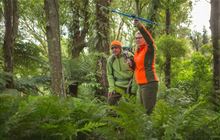How to inventory and monitor animal pests
Introduction
This module is the DOC’s standard to inventory and monitor animal pests.The module will help you to choose the most suitable methods for your situation. It's important to use monitoring methods in a consistent way and to the same standards. This will give you confidence in what the monitoring data is saying and help inform decisions.
How to use this module
- Read our Introduction to animal pest monitoring. In this document you will find comparative tables and decision trees to help you select the methods that are best for your study.
- Once you have selected the best methods, read the method descriptions to inventory and monitor animal pests. Be sure to take note of the minimum data collection standards for methods.
- Prepare your project.
- Read project planning guides to help with planning.
- Check if any online DOC training courses for your chosen method.
Introduction to animal pest monitoring
This document introduces the different methods to inventory and monitor animal pest populations.
Tables and decision trees will help you to decide on the methods appropriate for your project’s objectives. Some comparative tables and decision trees are specific to determining the most suitable methods for goat and deer monitoring.
Choosing the best method for animal pest monitoring (PDF, 702K)
Method descriptions
Deer - faecal pellet counts
This method describes faecal pellet counts as an index of abundance for deer.
Faecal pellet counts (PDF, 530K)
Deer and goats - camera trap catch
This method describes how to use motion-sensitive cameras to measure deer and goat relative abundance or presence/absence.
Camera trap catch indices for deer and goats (PDF, 1,587K)
Possums - trap catch
This method estimates the relative densities of possum populations.
Trap catch for possums (PDF, 691K)
Rabbits - spotlights
This method uses spotlights to estimate the relative abundance of rabbit populations.
Night counts for rabbits (PDF, 722K)
Rodents - snap traps
This method will give you a coarse index of the relative abundance of rodent populations.
Snap traps for rodents (PDF, 548K) Find out how to apply snap traps in the field (PDF, 1,069K).
Small mammals - tracking tunnels -
This method will give you a coarse index of the relative abundance of rodents or mustelids.
Tracking tunnels of small mammals (PDF, 608K) Find out how to apply tracking tunnels in the field (PDF, 1,029K).
Wallaby - counts
This method describes a case study which uses distance sampling to estimate the density and abundance of Bennett’s wallaby in South Canterbury, New Zealand.
Resources
- Tier 1 possum monitoring trials factsheet (PDF, 902K)
- How to cite publications in the toolbox.
- Project planning guides
- Online DOC training courses
More information
We welcome feedback and suggestions – contact biodiversitymonitoring@doc.govt.nz.

